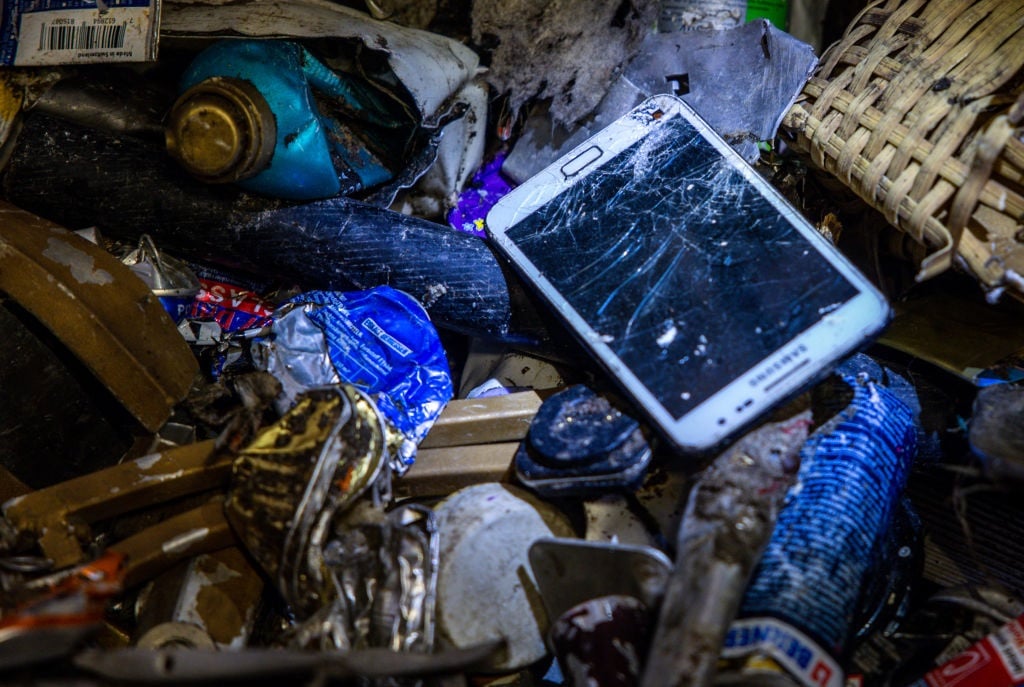
Jens Büttner/picture alliance via Getty Images
- A dog in the US caused a house fire by chewing through a lithium ion battery left within its reach.
- Ask a South African cellphone shop what to do with a phone battery and chances are they won’t have the right answer.
- South African cellphone companies are legally required to take responsibility for end-of-life phones and batteries – and there is a plan.
- For more financial news, go to the News24 Business front page.
A dog in Tulsa, Oklahoma, started a house fire after biting into a lithium ion battery. CCTV footage of the dramatic incident – which happened in May – was shared by Tulsa fire officials last week. It shows the portable cellphone battery sparking and then bursting into flames, as the dog which had been gnawing on it leaps away in terror.
The home was badly damaged by the fire, but the pets – two dogs and a cat – escaped through a hatch and were unharmed.
Fire department spokesperson Andy Little told ABC News that lithium ion battery fires were a “critical issue” affecting fire departments across the US. Extreme heat exposure, physical damage, overcharging and using incompatible charging equipment can lead to the devices catching fire.
Little urged the public to exercise caution with lithium ion batteries, including storing them out of reach of children and pets.
Closer to home, last month when Rupert Anelich visited the Vodacom shop in Brooklyn Mall to ask whether he could hand in a spent lithium ion battery from a cellphone for recycling, he was told “we don’t do that” and directed to a computer company. He followed that advice but was told to “just throw it in the rubbish”, he said.
But that’s far from appropriate advice, given the dangers involved, said Patricia Schröder, CEO of Circular Energy, the producer responsibility organisation (PRO) legislated by the Extended Producer Responsibility (EPR) regulations to manage end-of-life batteries. And that’s not all – solar energy equipment, domestic appliances, telecommunications equipment, power tools, product packaging, cables and more.
The regulations became effective from May 2021 but the companies which are required, in terms of the regulations, to register with Circular Energy and pay levies – those which import those products into the country, locally manufacture them or put them on the market – have been somewhat slow to come to the party.
“Vodacom and MTN came on board towards the end of last year and became compliant,” Schröder said.
That’s why, when News24 asked Vodacom about how it takes responsibility for their old cellphones and their batteries, the company responded with very practical advice. “All Vodacom customers can use the Circular Energy platform to get their devices collected by [the PRO] in the comfort of their homes.
“They can simply visit Circular Energy’s website and click on the button ‘Request Collection’ for the designated waste streams.”
MTN’s response also confirmed that it had registered with Circular Energy, but offered no practical advice on the disposal of the hardware it puts out in the market.
Circular Energy uses the companies’ levies to fund the environmentally sound management of that old tech stuff and that includes discouraging behaviour that puts lives at risk, particularly when it comes to batteries.
Schröder explained: “We appoint partners to collect, transport and recycle portable batteries, and we have enabled collection facilities at retail outlets.
“Many Woolworths branches throughout the country accept portable batteries – those which fit comfortably in your hand – as well as small household lighting bulbs.”*
And Hirsch’s outlets also have containers for used portable batteries, Schröder said.
“Some licensed facilities accept lithium ion batteries, and then crush, recover and separate the various materials for use in other applications.”
Schröder cautioned consumers about dodgy-looking old batteries.
“If it has swelled or looks ready to explode, don’t take it to a public collection point, especially not lithium ion batteries, which can ignite,” she said. “Rather contact us and we will collect it from you.”
If the lithium ion battery is intact, she said, tape it up with packaging tape to protect the terminals, and deposit them at one of the collection points. That’s especially important advice if the battery was bought online or is a cheaper imitation brand “which are not as safe in terms of integrity as original batteries”, Schröder said.
Staff at collection points are being trained to tape up lithium ion batteries if consumers have failed to do so, she said. Lithium ion batteries can be identified by the letters LI-ON on them.
If you are handing over an old tablet, laptop or phone, you should do so with the battery contained in it.
*All participating stores are listed on the Circular Energy website: circular-energy.org





Recent Comments